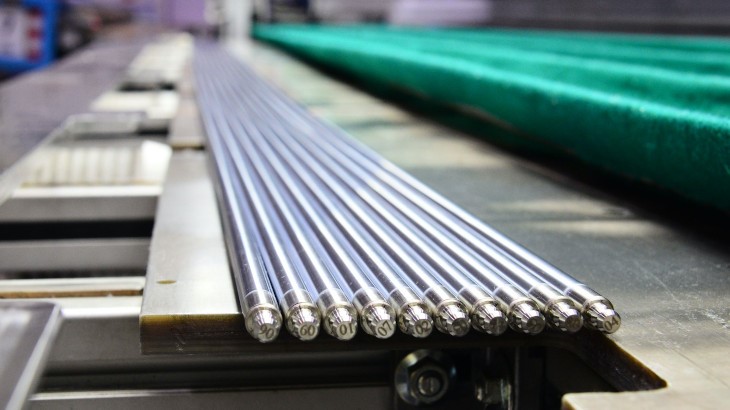Trial of advanced fuel begins at Rostov
Advanced fuel assemblies have begun an operational trial at Russia's Rostov nuclear power plant. Fuel manufacturer TVEL said if successful they would provide a higher level of performance and safety. "Fuel irradiation in a commercial reactor is an important step for the further commercialisation of this product," said Natalia Nikipelova, president of TVEL, adding: "It is symbolic that this milestone is achieved when TVEL celebrates its 25th anniversary."

Fuel rods during manufacturing (Image: TVEL)
Three fuel assemblies which each contain 12 experimental rods were loaded into unit 3 of the Rostov plant when it came back into operation from scheduled maintenance. Six rods have cladding made from chromium-nickel alloy, and the other six have a standard zirconium alloy cladding with chromium coating.
The use of these metals can "completely eliminate or significantly slow down" the zirconium-steam reaction, which has produced hydrogen in historical nuclear accidents, TVEL said. It was this hydrogen that caused the extensive damage to the reactor buildings at Fukushima Daiichi and it also played a role in worsening the Chernobyl accident. Eliminating this possibility would mean a step-change in the safety of a majority of the world's operating nuclear reactors.
Nikipelova said that according to "international analysts" advanced fuels "will dominate the global market in a relatively short time period". Fuel assemblies typically stay inside a reactor for about five years, therefore a total switch to advanced fuel in an operating power plant, or indeed the whole industry, could be carried out in that kind of timescale.
Within the metal cladding, nuclear fuel in commercial light-water reactors like Rostov is usually ceramic pellets of uranium dioxide enriched to around 5% uranium-235. TVEL said that alternative fuel compositions "could also make operation more economically efficient without increasing the level of uranium enrichment."
Since 2018, Rosatom has been testing advanced fuel for its VVER reactors. Its experimental designs completed two full irradiation cycles in the MIR research reactor and TVEL said they remained hermetically sealed, meaning they were not distorted "too much" by the intense heat, pressure and radiation of the reactor core.
Four different combinations of cladding and fuel matrix materials have been tested in MIR: in addition to uranium dioxide, uranium-molybdenum alloy with high thermal conductivity has been also used for fuel pellet fabrication. However, TVEL made the "conservative" choice of using uranium dioxide in the Rostov trial, saying there was international consensus that new fuel matrices should be introduced gradually.
Researched and written by World Nuclear News
- China Institute of Atomic Energy
- Nuclear Power Institute of China
- Southwestern Institute of Physics
- China Nuclear Power Operation Technology Corporation, Ltd.
- China Nuclear Power Engineering Co., Ltd.
- China Institute for Radiation Protection
- Beijing Research Institute of Uranium Geology (BRIUG)
- China Institute of Nuclear Industry Strategy (CINIS)
- China Nuclear Mining Science and Technology Corporation


